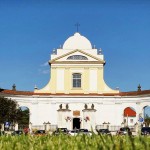Tykocin One of the oldest settlements in the Podlaskie Voivodeship
Tykocin (Yiddish: טיקטין) is one of the oldest settlements in the Podlaskie Voivodeship, which played an important role in Poland’s history. Nowadays a small town of 2,000 inhabitants, located on the Narew river, just 30 km from Białystok, the region’s capital. Despite it’s small size, there are many points of interest within walking distance from the central square.
The name of Tykocin was first mentioned in the 11th century. Tykocin received city rights in 1425, but several months later it was given to Grand Duchy of Lithuania by the Polish king Władysław II Jagiełło. In the XVI century, the town became one of the most favorite properties for Polish king and Lithuanian Grand Prince Sigismund II Augustus. He had a Renaissance castle built there instead of the medieval one. After the Partitions of Polish-Lithuanian Commonwealth the town was sold to the Prussian government. In 1807 it was given to Russia but in 1815 it was returned to the Kingdom of Poland. During the interwar period, the population of Tykocin had reached an estimated 4,000 inhabitants (twice as many as now).
During the World War II the Jewish population of Tykocin estimated at 2,000 people was eradicated by Nazi Germans. In 1950 Tykocin lost its city rights due to heavy loss of life, only to regain it in 1993 after the collapse of communism.
The main tourist attractions are: Tykocin Castle built in the XV century and partially reconstructed in 2005, baroque Church of the Holy Trinity and Baroque Synagogue Bejt ha-Kneset ha-Godol, built in 1642, one of the best preserved in Poland from that period. Other points of interest include the Jewish cemetery, one of the oldest in Poland or a Baroque monastery dating from the XVIII century. Nature lovers willing to watch white storks, very common the area, shoud visit in spring or summer. Do not miss nearby Kiermusy and Pentowo, the European Stork Village, just 3km from Tykocin!
Short movie about Tykocin:









Leave a Reply